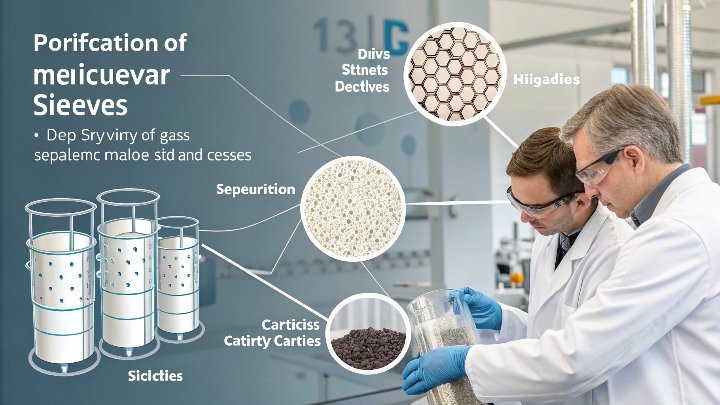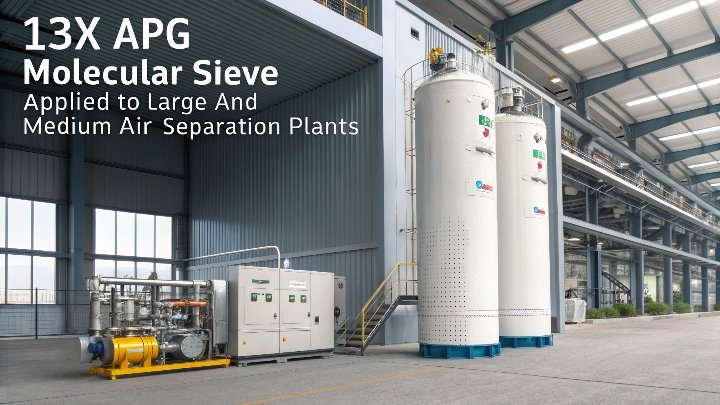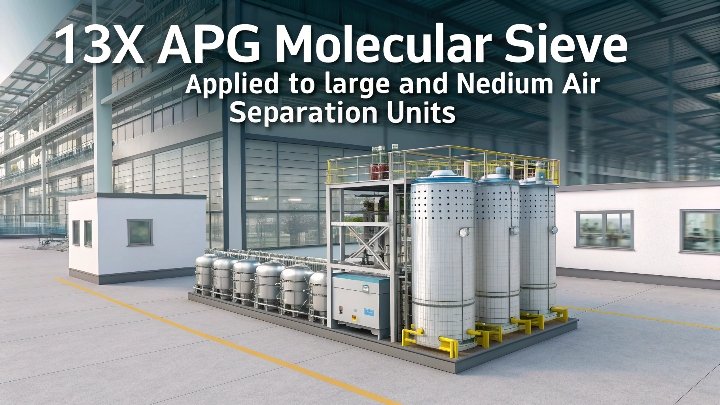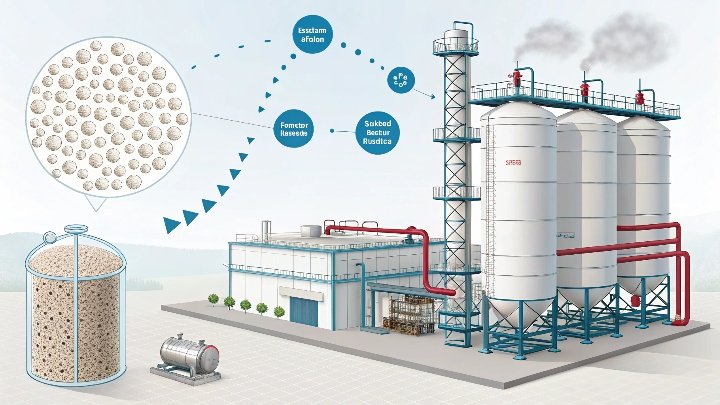I once struggled with moisture issues in my air separation setup. Then I found 13X APG. It changed my process, kept my system stable, and boosted my confidence.
13X APG is a molecular sieve with a 10 Å pore size. It is made for cryogenic air separation and stops tower freezing. It adsorbs carbon dioxide, water, acetylene, and other contaminants. This leads to smooth operations, consistent performance, and less downtime.
I am excited to share more details about how this unique adsorbent works. Let me show you why many industries trust it.
What’s So Special About 13X APG Molecular Sieve?
I was curious about how a small crystal could fix large-scale problems. I soon learned about 13X APG’s unique composition, and it saved me from complicated breakdowns.
13X APG uses a nano-X crystal structure. It was designed for deeper CO2 and water adsorption. It fits big or small cryogenic plants. This special composition helps keep processes steady, prevents freezing, and keeps everything running. That is why it is so special.
I remember my first exposure to 13X APG. I had a large air separation unit that kept showing signs of tower freezing. My team and I had tried different approaches, like adjusting temperatures and flow rates. But the freezing problem kept coming back. Then we decided to swap our older sieve with 13X APG. We noticed a big difference. The tower stayed operational, and the frequency of shutdowns became almost zero.
I realized the reason was in the pore size. The 13X APG molecular sieve has a pore size of 10 Å, which is bigger than the pore size in many standard 4A or 5A sieves. This means it can capture carbon dioxide, water, acetylene, and other harmful molecules without much effort. I like to think of it like a specialized filter that traps the stuff you do not want. At the same time, it lets the main gas pass through. This is good for cryogenic air separation because it stops ice formation. It also helps maintain stable temperatures.
The nano-X crystal structure is another part of its magic. It was designed specifically for deep adsorption of carbon dioxide and water. It is more efficient because it has a large surface area and a stable pore arrangement. In a process like cryogenic air separation, having a strong adsorbent means less chance of downtime. It also means more consistent output of nitrogen and oxygen. I have seen how a stable adsorbent helps reduce the load on subsequent processing steps. When you have fewer impurities to remove downstream, you save energy and money.
Another benefit is versatility. I have used 13X APG in multiple systems. It works in large plants that process massive amounts of air. It also works in smaller units, where precision is crucial. This flexibility means you do not need different types of adsorbents for different scales. You can standardize on one type, which is helpful for inventory management.
That is why I believe 13X APG is so special. It answers the need for a reliable adsorbent in cryogenic air separation. It stops freezing, handles multiple contaminants, and keeps the process on track. I saw the improvements in real time. It is not just a theory. It is something I experienced with my own system. That is what made me trust it.
Where Does 13X APG Shine? Top Applications Revealed!
I used to wonder if one material could handle many tasks. I discovered 13X APG can. It fits refining, petrochemical, and cryogenic air separation processes. That was a game changer for me.
13X APG is mainly used to remove H2O and CO2 from process streams in air separation units. It also helps in liquefying hydrocarbons, purifying natural gas, and desulfurizing liquefied hydrocarbons. It can dry gases deeply, separate and purify liquids, and even serve as a catalyst carrier.
When I first studied 13X APG, I was amazed at its wide range of uses. I saw it in large air separation facilities, where it was the backbone of moisture and CO2 removal. Then I noticed it in natural gas plants, where it helped remove undesirable components like water vapor and small hydrocarbons. That pointed me toward how flexible it is.
In oil refining, you often deal with complex hydrocarbon mixtures. I once visited a refinery that aimed to improve the purity of its feedstock for downstream units. The engineers there told me they switched to 13X APG for key separation steps. They needed to remove water, CO2, and some sulfur compounds. The results were impressive. The feedstock quality improved, and the catalyst in their reaction unit stayed active longer.
I also saw how 13X APG performs in petrochemical processes. The nature of petrochemicals often requires precise control of contaminants. You do not want to clog or poison catalysts. You also do not want to reduce yields because of side reactions. So this sieve helps ensure that key impurities, including trace acetylene or other reactive hydrocarbons, get captured. That safeguards the rest of the process.
The same goes for natural gas treatment. Natural gas often has moisture, carbon dioxide, and hydrogen sulfide. Those can cause pipeline corrosion or freezing in cryogenic liquefaction. 13X APG can handle deep drying. It can also help in partial desulfurization. That keeps the gas stable for transport or liquefaction.
Below is a simple table I use to explain the main applications:
| Application | Key Advantage |
|---|---|
| Large air separation units | Removes CO2 and H2O, prevents freezing |
| Natural gas processing | Adsorbs water and pollutants |
| Refining and petrochemical | Protects catalysts, purifies feedstock |
| Hydrocarbon liquefaction | Minimizes moisture and ensures quality |
| Industrial gas purification | Provides deep drying and clean output |
I believe this table sums up why 13X APG is so popular. It is not limited to one niche. It excels in many areas, especially when you need deep adsorption of CO2, water, and other contaminants. That is important in cryogenic processes. It also matters for other industries that want stable operations and fewer impurities. I like how it tackles many problems at once. That saves time and money.
I have recommended 13X APG to colleagues working in metallurgy, electronics, and even the medical field. They needed reliable adsorption solutions. They wanted to remove small amounts of water and other unwanted compounds. Whenever they tried 13X APG, they reported better yields, fewer shutdowns, and consistent product quality. That is why I say it truly shines in multiple applications.
Why 13X APG is a Total Industry Rockstar
I used to believe that adsorbents were all the same. But 13X APG stands out with strong performance, stable operation, and a proven record in cryogenic air separation.
13X APG remains a top choice for its high CO2 and water adsorption. It keeps processes smooth, avoids downtime, and delivers reliable results. Its design suits many industries looking for efficiency.
When people call it a “rockstar,” they are talking about the way 13X APG solves multiple pain points. I saw it reduce energy costs by keeping systems running without frequent regeneration cycles. Regeneration can be costly, because you need heat or vacuum steps to drive off the adsorbed impurities. If an adsorbent has a high capacity and efficient adsorption, you can go longer between those cycles. That means you use less energy overall. It also means you spend less time stopping the process for regeneration.
Another reason is its resilience against contamination. I have worked with other adsorbents that quickly degrade when exposed to certain hydrocarbons or moderate sulfur levels. But 13X APG has a robust structure. It can handle trace contaminants without losing its core adsorption efficiency. This matters in real-world settings where feedstocks are not always pure. Sometimes, you get unexpected spikes of certain compounds. If your adsorbent fails under those conditions, you face shutdowns. With 13X APG, I noticed fewer surprises.
I also saw how 13X APG can improve overall product purity. In cryogenic air separation, you often want high-purity nitrogen or oxygen. Traces of carbon dioxide, water, or hydrocarbons can ruin that purity. They can also freeze or clog cryogenic equipment. Because 13X APG removes those impurities well, you get a cleaner gas output. That means higher quality oxygen or nitrogen. It can also help with argon production, because argon separation relies on a stable feed. If the feed is full of contaminants, the entire process becomes less efficient.
There is also the factor of longevity. I have used adsorbents in the past that had good capacity at first but wore out quickly. 13X APG, in my experience, keeps working longer. That means fewer replacements. In large-scale operations, frequent adsorbent changeouts can be a major headache. The cost of adsorbent is one thing, but the downtime to replace it can be a bigger problem. So an adsorbent that lasts longer can save a lot of money in the long run.
Lastly, I noticed that 13X APG has strong backing from many suppliers and manufacturers. That means you can usually find it in different regions. If you are running a global operation, supply chain consistency is key. You do not want to rely on a material you cannot get. This availability makes it easier to standardize on 13X APG across multiple plants. It brings consistency to operating procedures. It also allows for shared best practices among different sites. I have often shared case studies with teams in other countries, and we found that 13X APG performed well across different process conditions.
From lower costs, to easier maintenance, to better purity, that is why I call 13X APG a rockstar in the adsorbent world. It excels where many others fall short. It is a proven solution that tackles critical problems in air separation, petrochemical, refining, and more. I am happy to rely on it because it has earned its reputation as a dependable performer in demanding industries.
Conclusion
I trust 13X APG because it removes contaminants, saves energy, and prevents freezing. It makes processes stable and keeps everything running with fewer worries.






